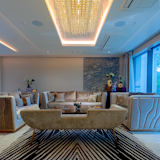Textural Storytelling: Layering Materials to Create Depth and Emotion
Credits
From Design Essence
In architectural interior design, textures are more than just aesthetic elements—they're the unsung heroes that transform spaces into experiences. Textural storytelling, an art form in its own right, combines diverse materials to create depth and evoke emotions. In this article, Jasleen Chalotra, Founder of Design Essence explores how layering materials can redefine your interiors and breathe life into your designs.
1. The Art of Layering: Creating Visual and Tactile Harmony
Layering textures involves combining materials with varying finishes, colors, and tactile qualities to create a harmonious interior. For instance, pairing rough natural stone walls with smooth marble flooring or soft velvet upholstery with metallic accents can create an intriguing contrast. This interplay of textures adds a sense of movement, transforming static spaces into dynamic narratives.
2. Emotions Through Textures: The Psychology of Touch
Different textures evoke distinct emotional responses. Smooth surfaces like polished wood or glass convey sophistication and calmness, while coarse textures like exposed brick or jute add warmth and earthiness. Combining these thoughtfully can shape the mood of your interiors.
For example:
Corporate Spaces: Incorporate sleek, reflective surfaces to inspire productivity and innovation.
Residential Interiors: Blend soft fabrics with organic textures for a cozy, inviting ambiance.
SEO Tip: Use keywords like "emotional design," "tactile interior materials," and "texture psychology" to target readers interested in human-centric design.
3. Materials Matter: Choosing the Right Elements for Your Story
From natural stone and wood to fabric and metals, every material tells a unique story. Opt for materials that align with the theme of your space:
Modern Minimalism: Concrete, glass, and matte metals create a clean, understated look.
Luxury Interiors: Marble, velvet, and brass elevate the space with elegance.
Rustic Designs: Reclaimed wood, leather, and exposed brick bring an organic charm.
Mixing these materials strategically can help narrate your design's story while staying functional.
4. Bringing Textures to Life with Lighting and Accents
The magic of textures lies in how they interact with light. Natural daylight highlights the intricate details of rough surfaces, while ambient lighting can soften and add warmth to smooth textures. Additionally, accents like throw pillows, area rugs, and curated decor pieces can enhance your textural palette.
Conclusion
Textural storytelling is the bridge between function and emotion in design. By thoughtfully layering materials, you can create interiors that not only look stunning but also resonate on a deeper, emotional level. Whether you’re designing a luxury home or a modern office, remember that textures are the threads that weave the story of your space.
